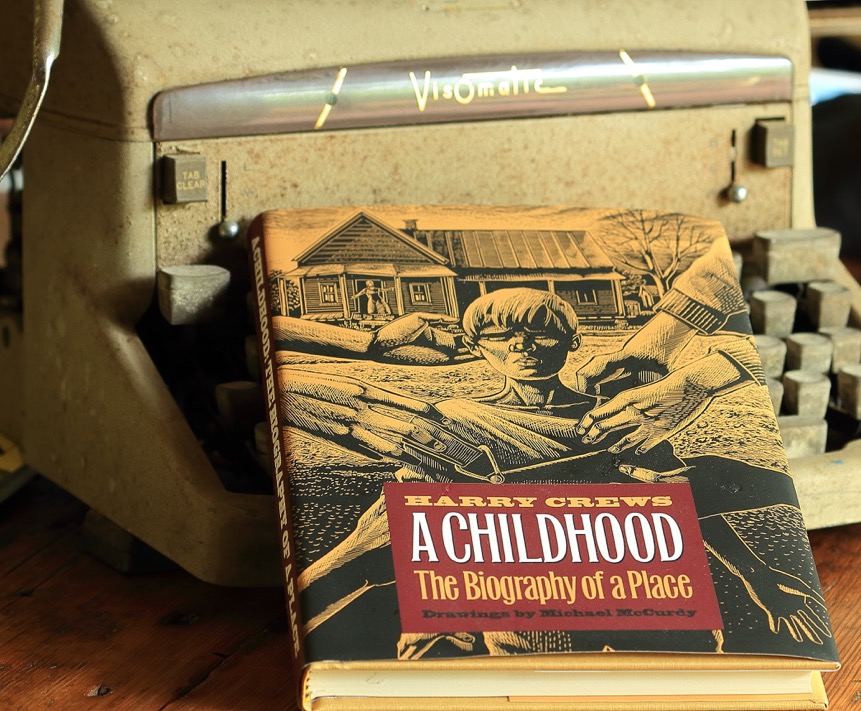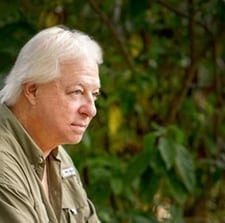A Childhood, The Biography of a Place
June 17, 2020By Tom Poland
The book is 9.25 inches long, 6.5 inches wide, and less than an inch thick. Its 182 pages present a world well-fed folks can only guess at. Harry Crews got just one Christmas gift as a boy, a Baby Ruth bar. That prepares us for a brutal world beautifully described.
Georgia writer Harry Crews used a typewriter but I choose to believe he wrote in longhand, a strong masculine script, each word articulated by his rough, raspy Georgia drawl. What I most like about Harry Crews is his fine way of rendering his rough childhood, so fine that he became the writer in residence at the University of Florida. How did the son of an alcoholic sharecropper become a writer? He lied about his age and joined the Marines. When his days as a Marine were over he sent himself to college on the GI Bill. Put that in your pipe and smoke it you holders of Masters of Fine arts in Creative Writing.
 Crews felt at home with and wrote about freaks as people who receive “special consideration from God.” A Childhood, The Biography of a Place first came to my attention when it was anthologized in Growing Up In The South, An Anthology Of Modern Southern Literature, 1991. I read Crews’s contribution over and over. He writes about growing up poor in Bacon County, Georgia. He writes about falling into a boiling cauldron of water during hog killing time. He writes about a year spent in bed, paralyzed by what was probably polio. He writes of the faith healer who tried to heal him, noting that the faith healer hadn’t healed his own walleye. He writes of growing up with the children of field hands.
Crews felt at home with and wrote about freaks as people who receive “special consideration from God.” A Childhood, The Biography of a Place first came to my attention when it was anthologized in Growing Up In The South, An Anthology Of Modern Southern Literature, 1991. I read Crews’s contribution over and over. He writes about growing up poor in Bacon County, Georgia. He writes about falling into a boiling cauldron of water during hog killing time. He writes about a year spent in bed, paralyzed by what was probably polio. He writes of the faith healer who tried to heal him, noting that the faith healer hadn’t healed his own walleye. He writes of growing up with the children of field hands.
The one joy in his impoverished life was the Sears Roebuck catalog. Crews and his black friend Willalee Bookatee would go through the catalog making up stories. Writes Crews, “The Sears, Roebuck catalogue was much better used as a Wish Book, which it was called by the people out in the country, who would never be able to order anything out of it, but could at their leisure spend hours dreaming over. Willalee Bookatee and I used it for another reason. We made up stories out of it, used it to spin a web of fantasy about us. The federal government ought to strike a medal for the Sears, Roebuck company for sending all those catalogues to farming families, for bringing all that color and all that mystery and beauty into the lives of country people.”
Crews writes that all the people in the catalog were perfect and beautiful. “Their legs were straight and their heads were never bald and on their faces were looks of happiness, even joy, looks that I never saw much of in the faces of the people around me. Young as I was, though, I had known for a long time that it was all a lie. I knew that under those fancy clothes there had to be scars, there had to be swellings and boils of one kind or another because there was no other way to live in the world.”
Crews died March 28, 2012 in Gainesville, Florida, 156 miles south of Bacon County. Thanks to his remarkable gift, Crews leaves us lessons gained from growing up poor and being despised by people who were better off.
“Survival is triumph enough,” said Crews. Once you’ve read his book, A Childhood, you’ll agree.
A Childhood, The Biography of a Place, University of Georgia Press, 1995.
Hardcover
ISBN: 9-780-8203-1759-5
$29.95
Visit my website at www.tompoland.net
Email me at [email protected]















